The gospel-based Christian synthesis of the heritage of Jerusalem, Athens and Rome — led by the Apostle Paul (Cf. Ac 17, Rom 1, Ac 27) — is a core but often unacknowledged or even resented part of the historical foundation of our civilisation. A civilisation which within living memory was described by Churchill as Christian civilisation. Not too much further back, it was usually referred to as Christendom.
But now, we see all around us the fruit of a centuries-long push to discredit and break that vital connexion; which has often been accompanied by a tendency to paint the legacy of Christendom in the most lurid colours, as though all that we have inherited is oppression, discrimination, injustice etc. That culminated in recent years in the sort of ill-founded, ill-advised fulminations that came from the pens of the so-called new atheists.
However, that effort has a cumulative impact of polarising, clouding, poisoning and polarising the atmosphere. So, let us first pause to rebalance by citing Bernard Lewis from his famous essay on the roots of Muslim rage:
The accusations are familiar. We of the West are accused of sexism, racism, and imperialism, institutionalized in patriarchy and slavery, tyranny and exploitation. To these charges, and to others as heinous, we have no option but to plead guilty — not as Americans, nor yet as Westerners, but simply as human beings, as members of the human race. In none of these sins are we the only sinners, and in some of them we are very far from being the worst. The treatment of women in the Western world, and more generally in Christendom, has always been unequal and often oppressive, but even at its worst it was rather better than the rule of polygamy and concubinage that has otherwise been the almost universal lot of womankind on this planet . . . .
In having practiced sexism, racism, and imperialism, the West was merely following the common practice of mankind through the millennia of recorded history. Where it is distinct from all other civilizations is in having recognized, named, and tried, not entirely without success, to remedy these historic diseases. And that is surely a matter for congratulation, not condemnation. We do not hold Western medical science in general, or Dr. Parkinson and Dr. Alzheimer in particular, responsible for the diseases they diagnosed and to which they gave their names.
Sobering.
Let us therefore move beyond Overton Window agit prop games and rebalance our thinking on the heritage and relevance of Christian civilisation:
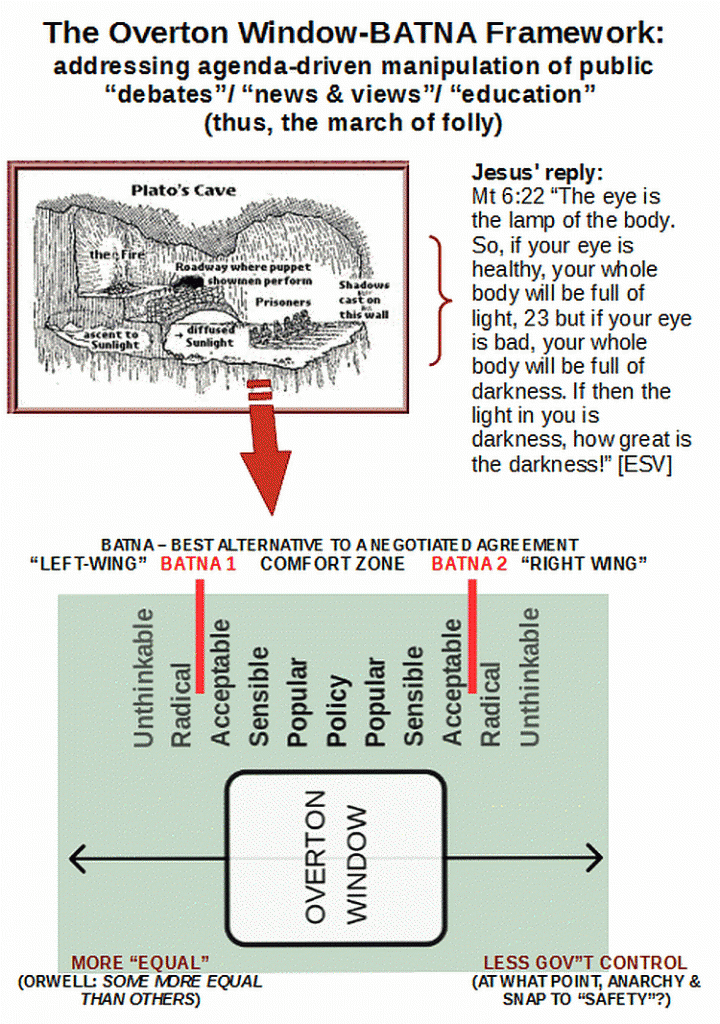
To do so, we will need to cultivate the art of de-spinning and seeking sound warrant on key issues:

Similarly, I think we will find an adapted form of Francis Schaeffer’s outline of the history of dechchristianising trends over the centuries in reaction to the Pauline synthesis quite useful as background. For, what we face today, below his line of despair, comes from a long line of cultural and intellectual and spiritual breakdown:
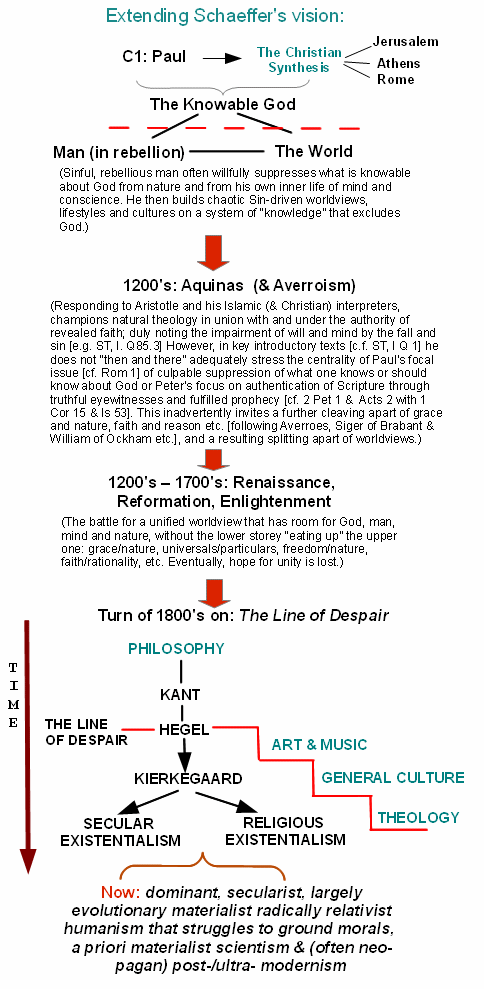
A key element in that analysis is the disintegration of worldviews as autonomous nature “eats up” grace:

As a result, Christians in our day are called to prophetically insightful intellectual and cultural leadership, to call us back from a civilisational voyage of folly:
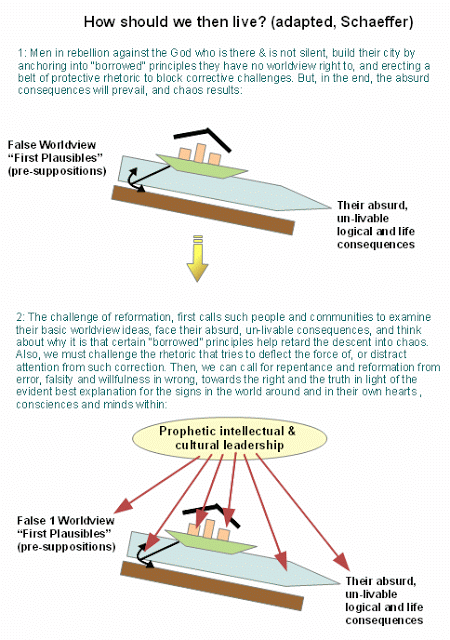
Let me add an illustration that helps us understand the faith-commitments that inevitably lie at the core of worldviews; which emerges as we reflect on the structure of warrant:
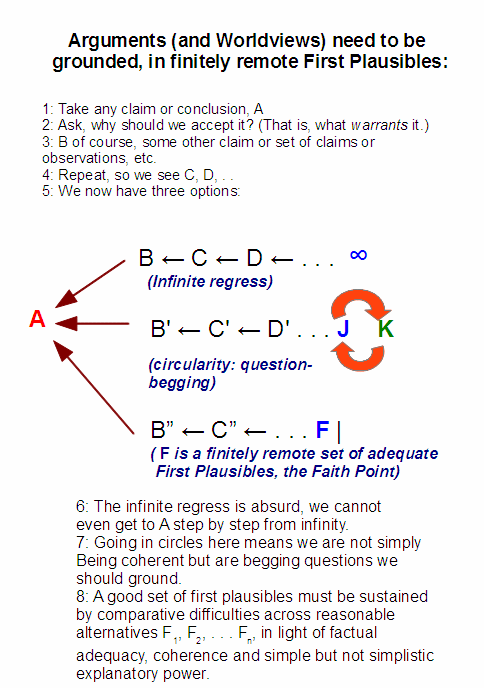
One useful tool in the required prophetically insightful intellectual and cultural leadership is the seven mountains of influence model (which also traces to Schaeffer et al though it has been championed by Wallnau et al in recent years):
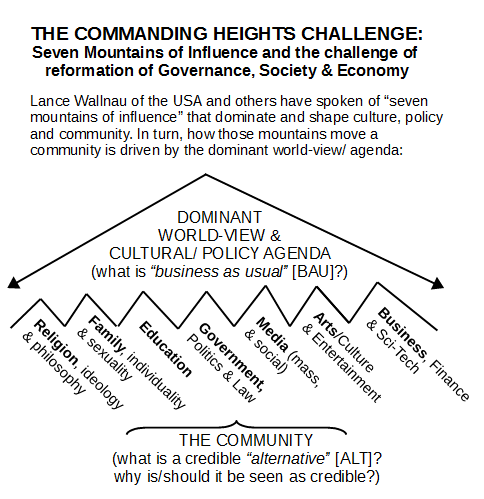
We may extend this model into the four R’s of godly reformation through discipleship:
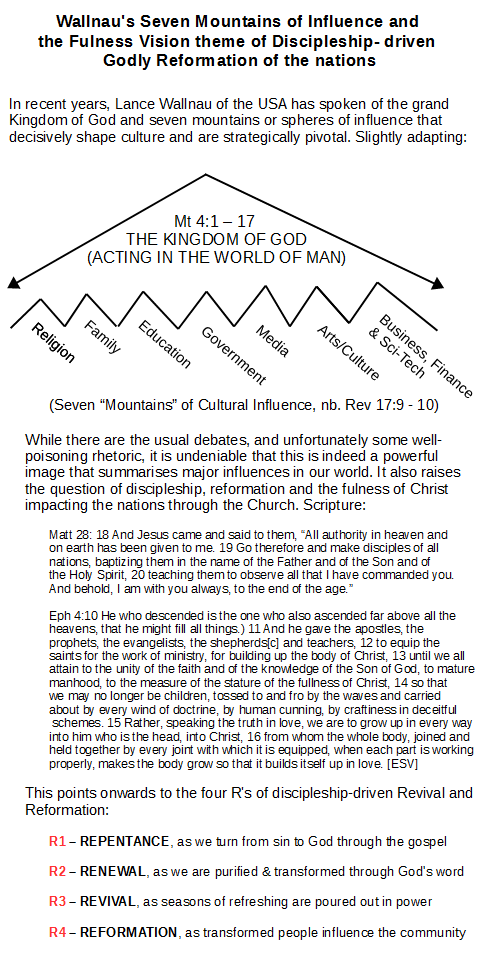
But, is such an approach well-founded? Yes, the gospel claims to be well warranted truth and necessarily incorporates moral transformation (as we face the discipleship-call to repentance, renewal and transformation from sinful lifestyles), but is that so?
Yes.
For one, we may use the so-called minimal facts approach to see just how well warranted the gospel is. Summarising from Apologetics Wiki:
The minimal facts method only uses sources which are multiply attested, and agreed to by a majority of scholars (ranging from atheist to conservative). This requires that they have one or more of the following criteria which are relevant to textual criticism:
Multiple sources – If two or more sources attest to the same fact, it is more likely authentic
Enemy attestation – If the writers enemies corroborate a given fact, it is more likely authentic
Principle of embarrassment – If the text embarrasses the writer, it is more likely authentic
Eyewitness testimony – First hand accounts are to be prefered
Early testimony – an early account is more likely accurate than a later oneHaving first established the well attested facts, the approach then argues that the best explanation of these agreed to facts is the resurrection of Jesus Christ . . . . [Source: “Minimal facts” From Apologetics Wiki. Full article: here. (Courtesy, Wayback Machine.)]
A list of these facts can be compiled, up to a dozen:
1. Jesus died by crucifixion [–> which implies his historicity!].
2. He was buried.
3. His death caused the disciples to despair and lose hope.
4. The tomb was empty (the most contested).
5. The disciples had experiences which they believed were literal appearances of the risen Jesus (the most important proof).
6. The disciples were transformed from doubters to bold proclaimers.
7. The resurrection was the central message.
8. They preached the message of Jesus’ resurrection in Jerusalem.
9. The Church was born and grew.
10. Orthodox Jews who believed in Christ made Sunday their primary day of worship.
11. James was converted to the faith when he saw the resurrected Jesus (James was a family skeptic).
12. Paul was converted to the faith (Paul was an outsider skeptic).
Why are such generally accepted? As I summarised:
That a Messiah candidate was captured, tried and crucified — as Gamaliel hinted at — was effectively the death-knell for most such movements in Israel in the era of Roman control; to have to report such a fate was normally embarrassing and discrediting to the extreme in a shame-honour culture. The Jews of C1 Judaea wanted a victorious Greater David to defeat the Romans and usher in the day of ultimate triumph for Israel, not a crucified suffering servant. In the cases where a movement continued, the near relatives took up the mantle. That is facts 1 – 3 right there. Facts 10 – 12 are notorious. While some (it looks like about 25% of the survey of scholarship, from what I have seen) reject no 4, in fact it is hard to see a message about a resurrection in C1 that did not imply that the body was living again, as Wright discusses here. Facts 5 – 9 are again, pretty clearly grounded.
So, the challenge is to explain this cluster or important subsets of it, without begging questions and without selective hyperskepticism.
It is not hard to see why the old objections commonly seen since C17 – 18 have fallen by the wayside; they just cannot cover the facts. Today, there are two men left standing: [A] the historic Christian view and [B] some sort of mass hallucination theory.
Of these, the latter is exceedingly problematic, as ” collective visions are not psychologically plausible as the cultural expectations of a resurrection would have been of a general one in the context of the obvious military triumph of Israel. Nor, does it explain the apparently missing body. Moreover, we know separately, that the culturally accepted alternative would have been individual prophetic visions of the exalted that on being shared would comfort the grieving that the departed rested with God.”
We are therefore left with the Morison challenge:
[N]ow the peculiar thing . . . is that not only did [belief in Jesus’ resurrection as in part testified to by the empty tomb] spread to every member of the Party of Jesus of whom we have any trace, but they brought it to Jerusalem and carried it with inconceivable audacity into the most keenly intellectual centre of Judaea . . . and in the face of every impediment which a brilliant and highly organised camarilla could devise. And they won. Within twenty years the claim of these Galilean peasants had disrupted the Jewish Church and impressed itself upon every town on the Eastern littoral of the Mediterranean from Caesarea to Troas. In less than fifty years it had began to threaten the peace of the Roman Empire . . . .
Why did it win? . . . .
We have to account not only for the enthusiasm of its friends, but for the paralysis of its enemies and for the ever growing stream of new converts . . . When we remember what certain highly placed personages would almost certainly have given to have strangled this movement at its birth but could not – how one desperate expedient after another was adopted to silence the apostles, until that veritable bow of Ulysses, the Great Persecution, was tried and broke in pieces in their hands [the chief persecutor became the leading C1 Missionary/Apostle!] – we begin to realise that behind all these subterfuges and makeshifts there must have been a silent, unanswerable fact. [Who Moved the Stone, (Faber, 1971; nb. orig. pub. 1930), pp. 114 – 115.]
This, then, is the guilty secret at the heart of today’s hyperskepticism toward, dismissal of, apostasy from and hostility against the historic Christian faith: the evidence that warrants that faith is not only credible but strong. (I add: especially, once blatant question-begging through anti-supernaturalistic prejudice is off the table. [Kindly cf. vid 1 below.])
Something, we need to face.
I think a video presentation may help some. First, background:
Next, the in a nutshell:
Those who want more may find Habermas himself helpful:
Others may find Craig helpful:
Or even the Strobel 101:
Now, all of this is in a specific context, where not only traditional marriage but also even one’s genetically stamped identity as male or female and linked cultural patterns have come under considerable pressure from the dechristianisers. Accordingly, it is relevant to pause to note on how a material part of these things is embedded in the moral transformation necessarily and inextricably involved in discipleship (and the underlying naturally evident moral law holds for all).
A good place to start is, the gospel: Jesus of Nazareth fulfilled 700 + year old specific scriptural prophecies of Messiah, including particularly resurrection from the dead. In that context, with 500 eyewitnesses, most still alive when such was committed to record 55 AD, a record handed down to us in unbroken, good chain of custody.
Speaking of . . .
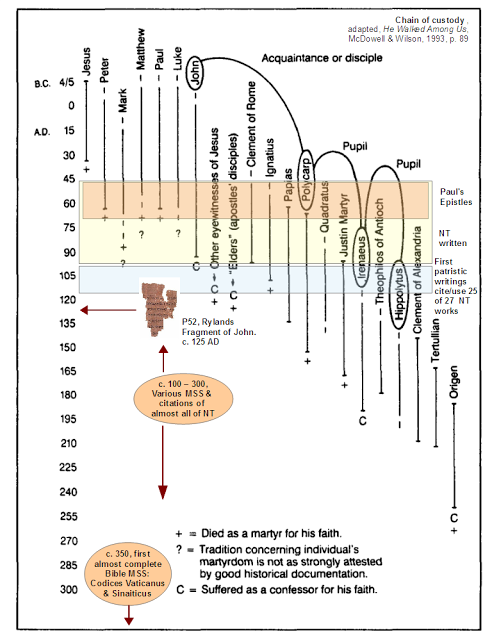
Let us quote that record, which points to the official summary of the witness of the 500, clearly dating to 35 – 38 AD in Jerusalem, far too early and far too central to be the stuff of readily dismissible legend:
1 Cor 15:1 Now I would remind you, brothers,[a] of the gospel I preached to you, which you received, in which you stand, 2 and by which you are being saved, if you hold fast to the word I preached to you—unless you believed in vain.
3 For I delivered to you as of first importance what I also received:
that Christ died for our sins in accordance with the Scriptures,
4 that he was buried,
that he was raised on the third day in accordance with the Scriptures,
5 and that he appeared to Cephas, then to the twelve.
6 Then he appeared to more than five hundred brothers at one time, most of whom are still alive, though some have fallen asleep.
7 Then he appeared to James, then to all the apostles.
8 Last of all, as to one untimely born, he appeared also to me . . .
11 Whether then it was I or they, so we preach and so you believed.
This puts the issues just addressed through the minimal facts approach at the centre of our self-understanding as morally governed creatures and as a civilisation. For, once we see the warrant for the gospel by this and other means, it demands a duty- to- warranted truth- response: we must accept, then live by truth we know or should acknowledge, per good warrant. In which context, demanding that the church move away from its warranted core is ill-founded. And a civilisation that could readily access such warrant but elects to ignore instead is telling us a lot about itself. Nothing good.
It also establishes a clear centre of authority regarding truth and right conduct, the one who broke death.
clear And, on marriage, gender, sexuality etc, this is his record:
Matt 19:4 He [Jesus] answered, “Have you not read that he
who created them from the beginning made them male and female
[–> Gen 1 – 2, note the identified, naturally obvious case of
two distinct, reproductively complementary sexes, here anchored to
creation order for the human race], 5 and said, ‘Therefore a man shall
leave his father and his mother [–> implying the successive
generations of families built on man + woman + faithful commitment
–> well-nurtured children] and hold fast to his wife [–>
fidelity propagates from one generation to the next, how much more so
infidelity], and the two [= husband (male) + wife (female)] shall
become one flesh’ [–> through the act of marital, procreative
union, naturally leading to children]? 6 So they are no longer two but
one flesh. [–> ponder how the child reflects that union] What
therefore God has joined together [–> Adam and Eve and their
successors in one flesh union], let not man separate [–>
including, how much more, by violating the nature of marital union:
Adam + Steve, Eve + Mary, Either + fido, or a robot etc].”
Notice, he points to the naturally evident creation order and how this grounds a law of our manifest nature.
Such is antecedent to governments or cultural customs, it cannot be made by them or materially altered by them.
That is what many would defy today, to the obvious detriment of the community as the stabilising family is steadily eroded. Oh, it may still stand for many years yet but the implications point to a hard collision with reality.
The pivot of hope for a civilisation heading for the cliff:
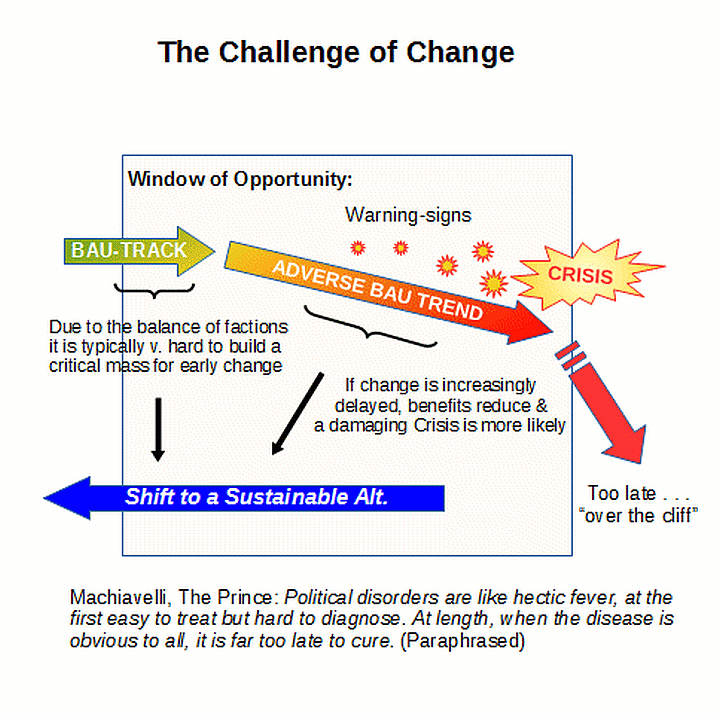
. . . is repentance towards the well-warranted truth and right attested by the gospel. So, will we turn back before it is too late? END